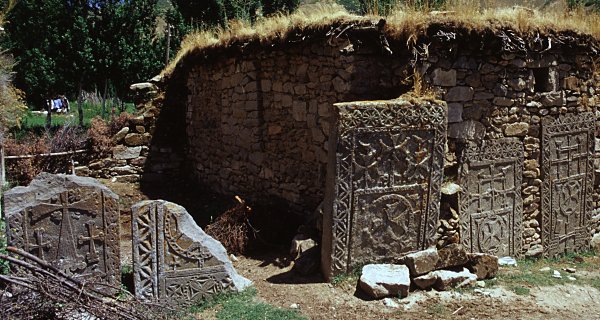Location
During the medieval period the region at the western end of Lake Van was called Bznumik. The village of Por, now called Değirmenaltı, is located about seven kilometres north-east of the town of Bitlis. Within the village is an Armenian church, called St. Anania, that dates from the sixth or seventh century. In the middle of the 15th century it was occupied by a community of Armenian monks who renovated the old church, built a zhamatun in front of its west wall, and probably also built the small chapel that is located to the south of the church. Both the church and the chapel are now used as barns. The zhamatun is now in ruins.
The Khatchkar Gravestones
Except from the khatchkars at Aprank, Değirmenalti village contains the most important collection of Armenian khatchkars now surviving in Turkey. They seem to mostly date from the 14th and early 15th centuries, from the period of the site's use as a monastery.
The photographs below show the majority of the khatchkars. Most stand to the south of the church and are arranged in two rows running north-south. In addition to those pictured, there is also a third row of smaller khatchkars, the stones of which now all lie either buried or toppled face-down. Another khatchkar, dated 1456, is built into the interior south wall of the St. Anania church. There are fragments of more khatchkars built into the walls of the chapel and into the walls of a barn that adjoins it to the north. Stylistically, the Por khatchkars are very distinctive. Unfortunately, because of the near total destruction of medieval Armenian graveyards in eastern Turkey i nthe post-Genocide period, it is difficult to place them into a local, regional, or national context. Not only are they distinctively different from khatchkars found in other parts of Armenia, they are also very different in design from surviving khatchkars from the eastern half of the Lake Van region, such as those on Aght'amar Island or at the Saint Argelan monastery near Muradiye. The widespread depiction of birds and fishes on the Por khatchkars is unusual, and the use of equal-armed Maltese crosses set within roundels in the second row of khatchkars seems to look back to motifs found in Armenian Christian monuments from much earlier times. The First RowThere are three khatchkars in this row, one of which is broken. All three of them carry inscriptions in Armenian and they are all dated 1496.
To the east of the first row of khatchkars there is a second row, this time with five khatchkars. Their designs are entirely different from those in the first row. The khatchkar on the left is dated 1513. The damage to it, and to its neighbour, is recent. 
Two More Khatchkars
NOTES:
The church and the khatchkars are described in a report by Jean-Michel Thierry published in Handes Amsorya, volume 89 (1975), pages 183-200, Vienna. This report was not available to me when writing this page. The church is also briefly described, with a plan, in Bitlis, Güroymak ve Tatvan'da 2000 yılı Arastırmaları, in Arastırma Kazı Sonucları Toplantısı, volume 19 (2001), part 1, pages 51 and 57, Ankara, 2002. |